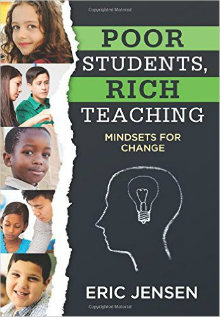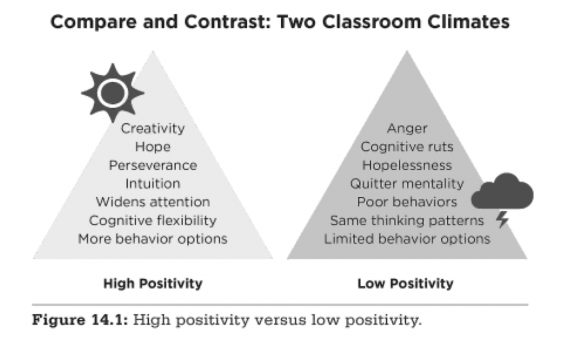How Rich Teaching Can Help Poor Students
Poor Students, Rich Teaching: Mindsets for Change (Raising Achievement for Youth at Risk)
By Eric Jensen
(Solution Tree Press, 2016 – Learn more)

Once again, Eric Jensen gives readers practical advice plus highly effective, research-based strategies in his newest book, Poor Students, Rich Teaching: Mindsets for Change. This title should be on all educators’ summer reading lists since the focus is on achieving success for students and their teachers.

- The Relational Mindset
- The Achievement Mindset
- The Rich Classroom Climate Mindset
- The Engagement Mindset
Readers will find research plus easy-to-implement strategies for each mindset. Jensen reminds readers that these strategies are not add-ons. “They are clear replacements for things you already do (that may be less effective).” (p. 20)
The Relational Mindset
The relational mindset says, “We are all connected in this life together. Always connect first as a person (and an ally) and then as a teacher second.” (p. 26) Students who feel connected will stay in school. The first strategy the author offers is so simple: learn students’ names. It doesn’t cost money; it doesn’t take much time, yet the benefits are enormous. He includes a dozen name-learning strategies for teachers as well as name-learning strategies for students.
Chapter 5 reminds readers of the relationship between belonging and academic success. Teachers who are reluctant to use cooperative learning groups or collaborative activities will find this section helpful.
In the section on empathy, Jensen includes some responses a teacher might use along with some Quick-Connect Tools. He is quick to point out that empathy is not a get-out-of-jail free card to be saved and played on rare occasions. It’s another way to connect with students and show you care, every day.
The Achievement Mindset
The achievement mindset says, “I can build student effort, motivation, and attitudes to succeed. They are all teachable skills.” (p. 60) With this mindset, teachers and students will succeed.
Not sure what to say to motivate students? Jensen provides 17 brain-smart motivators that will increase achievement.
Anyone who has ever heard Eric Jensen speak is familiar with his phrase “gaudy goals.” In Poor Students, Rich Teaching, he devotes a chapter to setting “gutsy goals.” No matter the name, the meaning is the same – “a jaw-dropping, nearly impossible, shoot-for-the-stars milestone.” (p. 70) Examples of process goals, relational goals, and result goals for elementary teachers, secondary teachers, and students are included. The author offers practical advice on topics such as having the right attitude, giving fabulous feedback, and persisting with grit.
The Rich Classroom Climate Mindset
The rich classroom climate mindset says, “I focus on what students need to succeed and build it into the learning and social environment every day.” (p. 111) Statistics show that a positive classroom/school climate results in improved student achievement.

Students need physical and emotional safety in the classroom. Jensen includes his thoughts on establishing classroom rules along with suggestions for creating new attitudes in the classroom. By reframing an assignment or activity, we can give students a dose of academic optimism.
The Engagement Mindset
The engagement mindset says, “I can and will engage with purpose every student, every day, every nine minutes or less, guaranteed.” (p. 148) Do not hyperventilate! Jensen assures readers the engagement process is not a “one-day miracle cure.”
Readers may be familiar with many of the activities suggested to maintain alertness. Also, the author includes activities to help students connect and control their stress. With the supporting research, educators will recognize the cognitive and behavioral benefits.
Chapter 21 on set up and buy-in is a critical piece in the engagement mindset; it may be short, but it is so full of ideas a second read is required. The author reminds readers of the value of classroom rituals in creating a classroom community. Classrooms will have fewer problems and be happier places when these engagement strategies are in place.
You do not need to teach in a high poverty school to read this book; more well-to-do students need rich teaching too. Poor Students, Rich Teaching: Mindsets for Change gets my vote for a faculty book study. A study guide and reproducibles are available from Solution Tree.
Anne Anderson is currently an Educational Consultant known for her practical ideas and engaging workshops. Anne’s goal is to help teachers help students. Her positive approach and sense of humor bring encouragement to her audiences. Anne seeks to provide educators with practical solutions to teaching and learning problems. Visit her websitewww.AnneAndersonEdu.com and subscribe to her bi-monthly newsletter, Spotlight on Success.






























